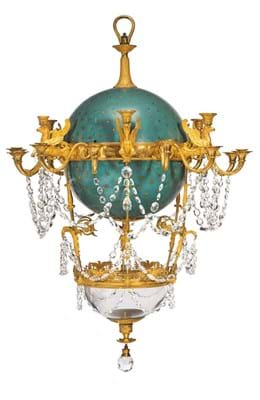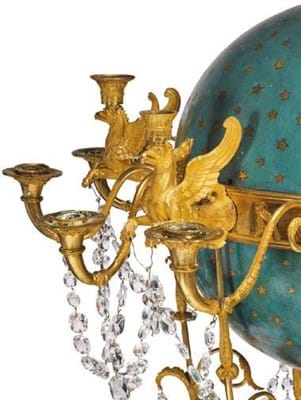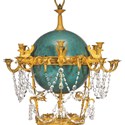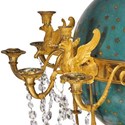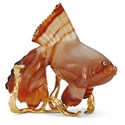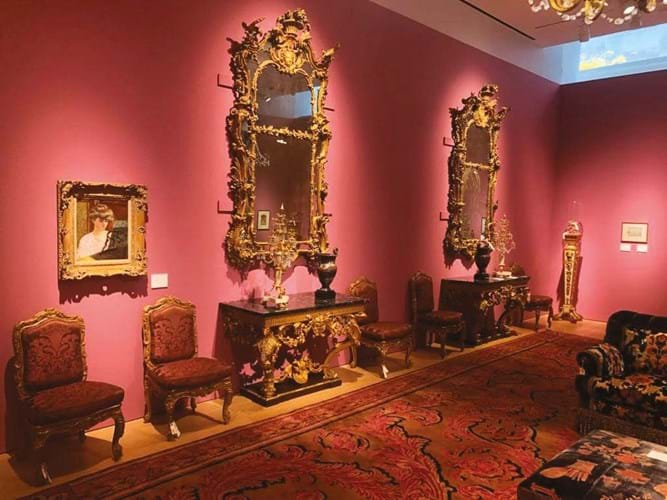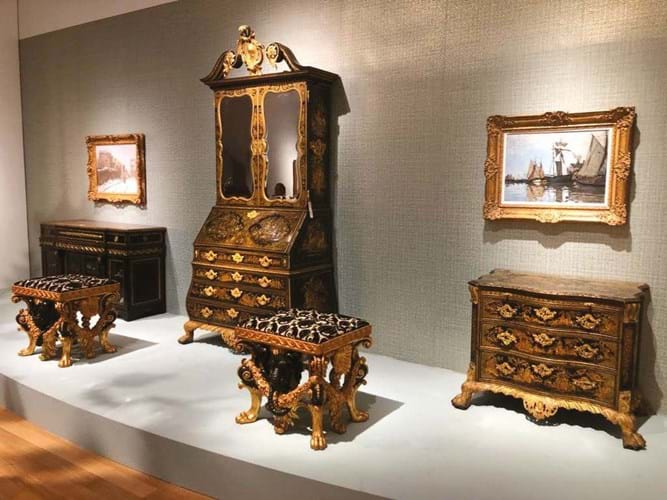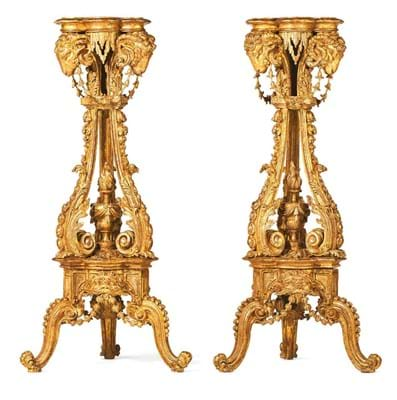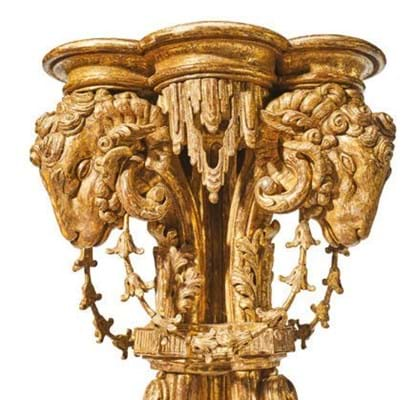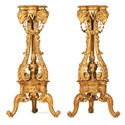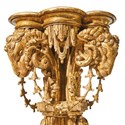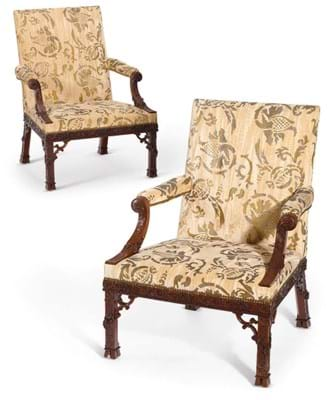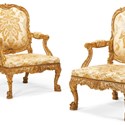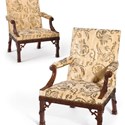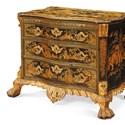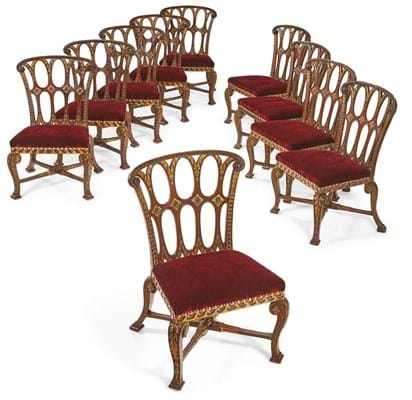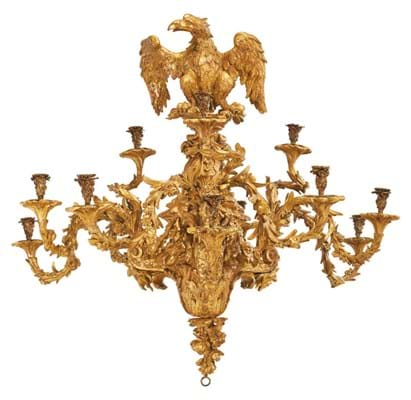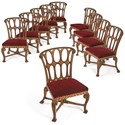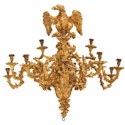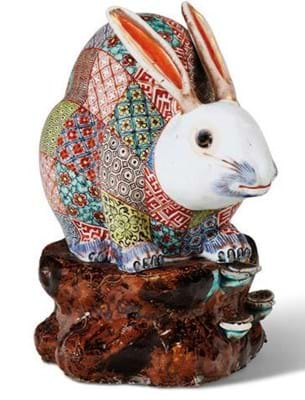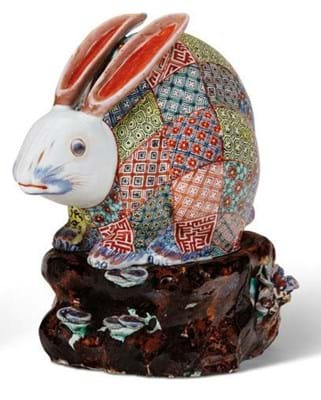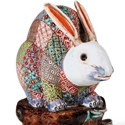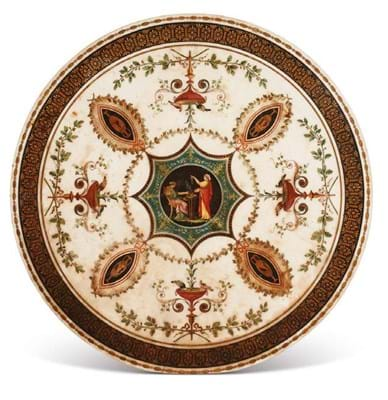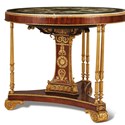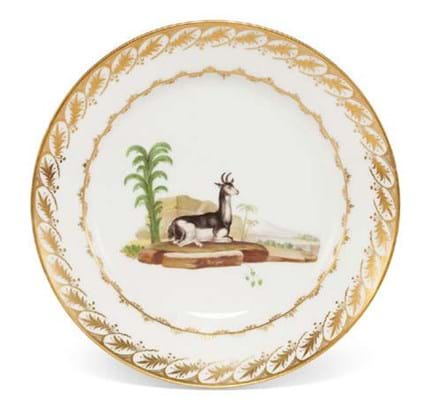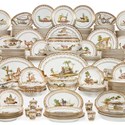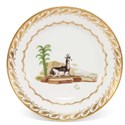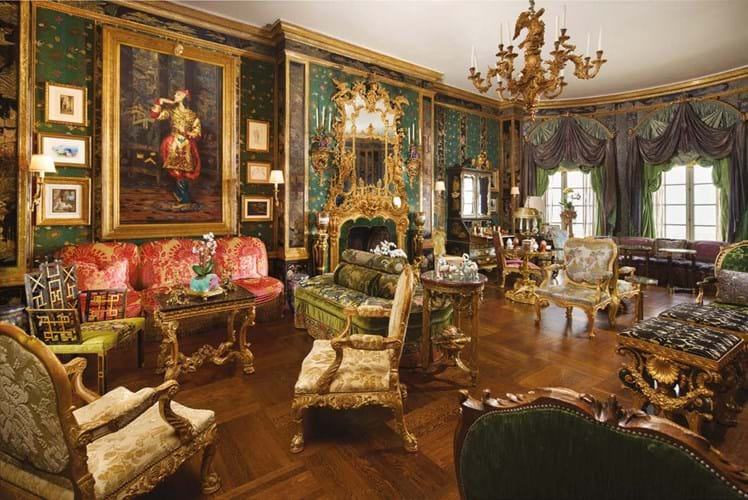
The living room at Ann and Gordon Getty’s residence in the Pacific Heights, San Francisco containing many of the pictures, furniture and furnishings sold at Christie’s New York. Using a ‘virtual reality’ mask Christie’s clients could take a tour of this extraordinary room.
Christie’s Images Ltd 2022
Surrounded by chinoiserie panels made for Augustus the Strong, guests were seated on Kentian chairs and ate from a porcelain service made for William I of the Netherlands.
On one occasion the hostess took to filling the glass bowl of a whimsical lustre à poisson chandelier with live goldfish – thus recreating the centrepiece of Gérard-Jean Galle’s stand at the Exposition des Produits de l’Industrie Française in 1819.
One can only imagine the consternation when – as the evening progressed – water from the chandelier began to leak onto the dining table and the poor fish expired.
Future mishaps were averted with the purchase of a Fabergé-style carved hardstone fish that, placed in the centre of the bowl, provided a low maintenance replacement.
Rich mix
Stories such as this abounded when the Ann and Gordon Getty collection was dispersed in close to 1500 lots in New York in late October.
Christie’s (26/20/14.5% buyer’s premium) sale occupied four days of live evening and daytime auctions (October 20-23) plus a further six online sales that ran until October 25.
On offer was an extraordinarily rich mix of works from Old Master and Impressionist pictures to the best in 18th century furnishings, bought from the late Seventies into the Noughties with Ann Getty’s interior decorating eye, great dedication, some good advice and an outstanding bank balance.
The proceeds from the sale, benefiting the Ann and Gordon Getty Foundation for the Arts, were more than $150m (including premium) – placing this firmly in the category of the recent ‘super collections’ alongside those of Peggy and David Rockefeller and Yves Saint Laurent and Pierre Bergé.
The English furniture was particularly good – in terms of quality and quantity the finest dispersal of its type for a generation. It included the mahogany ‘glasscase’ supplied by William Vile to Queen Charlotte (1744-1818) for St James’s Palace that (as reported in ATG No 2565) became one of the most expensive pieces of English furniture ever sold when it took $2.2m (£2m).
And this was just one of many pieces that had a rich history within the UK antiques trade.
Reappearing on the market after 40 years were an extraordinary pair of Chippendale giltwood torchères.
These were first mentioned in the Yorkshire Post in November 1924 as part of a contents auction at Denton Hall, near Otley, Yorkshire. They remained at the house under new owners (and were pictured in the Great Hall in a Country Life magazine article in 1939) but were sold by Henry Spencer & Sons in 1975 by which time – painted white and converted to lamps – they were thought to be Victorian reproductions. They were purchased for a song at the Chelsea Antiques Fair and later, after restoration revealed all, sold to Ann Getty in 1982.
Subsequently Chippendale’s near-identical drawing for the design (a ‘transitional’ synthesis of French-inspired rococo and neoclassicism) was found in an album at the Victoria and Albert Museum. Intriguingly, it had come by descent from the carver and designer Matthias Lock (c.1710-65) who, it seems, provided piece-work for Chippendale’s larger projects.
These torchères were estimated at $250,000-400,000 but sold at $820,000 (£725,665).
The same sum was achieved by another of the best performing furniture lots in the October 20 ‘chefs d’oeuvre’ sale, a pair of George II white painted and parcel gilt armchairs from the suite designed by the architect John Vardy (1718- 76) and supplied to Spencer House c.1758.
Intended to harmonise the architectural decoration of the Vardy’s-called Palm Room, the French-inspired suite (two large stools, two smaller stools, a single sofa, and eight armchairs) was probably executed by the Golden Square cabinet-maker John Gordon.
He clearly enjoyed a close relationship with John Spencer, later 1st Earl Spencer (1734-83), as he was appointed as an executor in his will.
The two large stools took £180,000 in the Spencer House sale (Christie’s, London, 2010) while the sofa (unsold at Sotheby’s in 2002 with a guide of £500,000-800,000) is now in the collection of the National Museum of Scotland. This pair of armchairs, previously owned by Henry Ford II, were sold from his estate by Sotheby’s New York in 1991.
This time, guided at $200,000- 400,000, they were bought by a UK-based private collector.
In total (and despite the strength of the dollar against sterling and the euro), 32% of lots sold to buyers from Europe, 55% from the Americas and a more modest 13% from Asia.
Renowned interior
The opening sale also included two ‘masterpiece’ lots from one of the most renowned interiors of the mid-Georgian era: St Giles’s House, Dorset.
The suite of exuberantly carved mahogany seating furniture supplied to Anthony Ashley-Cooper, 4th Earl of Shaftesbury (1711-71) in c.1760 is justly famous – one might even say infamous given the fakes that emerged on the market a generation ago. An extensive search of the Shaftesbury family papers has frustratingly revealed little in the way of direct payments to cabinetmakers.
However, the virtuoso suite was probably made c.1760 in the workshops of William Vile. Pieces from the suite, originally comprising four settees and 25 armchairs, were sold by the 10th Earl throughout the 1950s with this pair last at auction in 1995 when, at the peak of the market, they took $1.2m at Sotheby’s New York.
Prices have since dropped away and this time the pair sold well below hopes of $300,000-500,000 at $220,000 (£194,690).
Less well known are the giltwood furnishings produced for Ashley- Cooper in the early 1740s. It ties together the architect Henry Flitcroft (1697-1769), who transformed the original Jacobean house into a fashionable Palladian-style mansion, and Matthias Lock.
Alongside seating-furniture and wall lights sold off by trustees in 1980 was an ensuite giltwood and gilt bronze chandelier – a tour de force of carving and design combining Bacchic masks, shells, scrolls and a spread-winged eagle finial. At 4ft 5in (1.35m) diameter across, it is one of just three comparable pieces known. It had been acquired by the Gettys at Sotheby’s New York sale of the Estate of Wendell Cherry (1935-91).
Estimated at $300,000-500,000, it made $350,000 (£309,735).
Lock was the first to publish a comprehensive oeuvre of furniture designs in the English rococo style: his 1752 catalogue A New Book of Ornaments printed two years before Chippendale’s Director.
A pair of giltwood pier mirrors sold at $550,000 (£486,725) were among the earliest and most ambitious examples of the new style and almost certainly supplied to the diplomat and art collector Robert Trevor (1706-83) for Hampden House, Great Missenden.

Pair of giltwood pier mirrors c.1745 attributed to Matthias Lock from Hampden House, Great Missenden – $550,000 (£486,725) at Christie's sale of the Getty collection.
Christie’s Images Ltd 2022
The 8ft (2.47cm.) high mirrors (the central and some border plates replaced) were sold separately at a house sale in 1939 but subsequently reunited by the London dealer Botibol in the 1950s. They passed through several hands before they entered the collection of shipping magnate Eric Moller in the mid- 1960s.
Many pieces in the Getty collection combined both the academically important and the collection combined both the academically important and the supremely decorative.
Boring brown this was not.
Among its most celebrated components were a black and green and gilt japanned and parcel gilt bureau cabinet and matching chest of drawers attributed to the ‘great Dealer in the Cabinet way’ Giles Grendey (1693-1780).
This is the only surviving set of its type known to exist and they attest to Grendey’s European clientele and the wider appreciation of English japanned furniture in the 18th century.
The pair were essentially unknown for centuries until they surfaced for sale in 1979 at Christie’s in Rome as part of the contents from two villas owned by the Pallavicini family – perhaps Grendey’s original customer. Ann Getty bought the cabinet from Mallett in 1980 and the chest from Colnaghi the following year.
Estimated at $200,000-300,00, the chest of drawers proved the more desirable of the two pieces selling at $450,000 (£398,230).
The bureau cabinet, guided higher, took $360,000 (£318,585).
It’s no surprise to learn that the market is not where it was and not always able to absorb such a large quantity of material.
Another somewhat underwhelming sum – $420,000 (£371,680) against an estimate of $500,000-800,000 – bought a truly great set of 10 mahogany and parcel gilt dining chairs in the Palladian style.
With their distinctive pierced backs, solid seats, Vitruvian scroll aprons and fish-scale carving, they follow a muscular design by William Kent (1685-1748) and are attributed to Benjamin Goodison (c.1700- 67). Supplied in 1752, they formed the nucleus of a commission by prominent Whig politician Francis North, 1st Earl of Guilford (1732-92) for his townhouse on Grosvenor Square.
The full set originally comprised 12 chairs and two settees; the two extra chairs are in a private collection, one settee is at the Victoria and Albert Museum and the other is at Temple Newsam, Leeds. The chairs’ 20th century provenance is linked by Ethel Countess Beatty (1873-1932), the daughter of Chicago department store magnate Marshall Field, although they were acquired from James Hepworth by Ann and Gordon Getty in 1992.
And that ‘lustre à poisson’ that had provided the centrepiece to the Getty dining room? It went swimmingly.
Claude Galle’s celebrated ‘Montgolfier balloon’ design, acquired in 1988 at one of the British Rail Pension Fund sales at Sotheby’s, sold at $580,000 (£513,275).
The Fabergé-style gold, diamond and agate fish that sat proudly within the glass fishbowl brought $16,000 (£14,160).
Arita rabbits
The Gettys owned a fine collection of Chinese and Japanese export figures, many of them offered with modest expectations.
One of many stellar performing lots was this pair of 8½in (22cm) high Arita porcelain models of usugi (hares or rabbits) crouching on pierced rockwork bases. These are a well-known model (typicalled described as pastille burners) but this pair, acquired from A&J Speelman, London, in 1981, are brightly enamelled with trellis, cell and diaper pattern panels. Estimated at a lowly $5000-7000, they nonetheless pushed on to $180,000 (£159,290).
A similarly decorated pair is in the royal collection and part of the current Japan: Courts and Culture exhibition at the Queen’s Gallery. Acquired by George IV, in 1818 ’for Brighton’ when sent to Buckingham Palace in March 1847 they were described as ‘a pair of china rabbits enamelled in harlequin patches’.
Table carpet
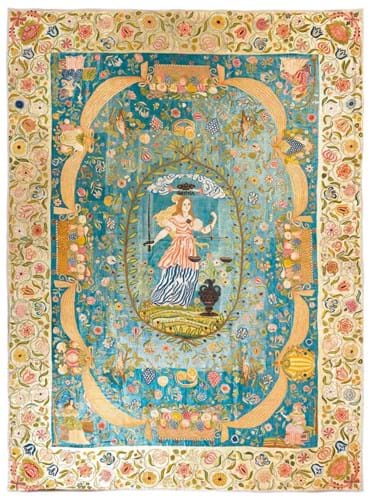
English table carpet – $55,000 (£48,670) at Christie's sale of the Getty collection.
Christie’s Images Ltd 2022
This English table carpet measuring 10ft 6in x 7ft 4in (3.3 x 2.2m) is worked in tent stitch on canvas in polychrome silk and metal thread with a central allegorical figure of Justice and is dated 1661 in silver thread.
The Justice figure is based on Crispijn van de Passe the Elder’s c.1580-88 engraving of the same subject after Maarten de Vos the Younger. Her attributes of Faith, Love, Hope and Humility are shown as figures in the corners of the carpet.
It was possibly made in celebration of the Restoration and the accession of Charles II to the English throne in 1660.
The carpet was formerly in the collection of the Pontremoli family who had workshops in Bayswater in 1910 producing home furnishings, including many carpets in late Renaissance and early Baroque styles.
Ann and Gordon Getty acquired this piece from a sale at Christie’s South Kensington in November 1994. Offered in the first evening session of the Getty auction on October 20 with an estimate of $80,000-120,000, it sold for $55,000 (£48,670).
Linnell’s chairs
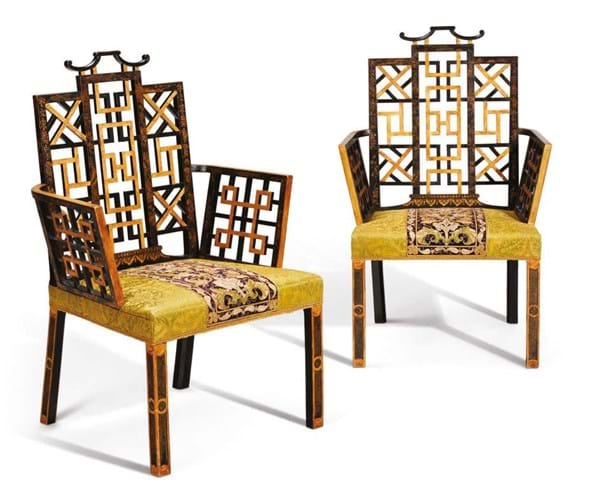
A pair of chinoiserie chairs from the Chinese Bedroom at Badminton House – $180,000 (£159,290) at Christie's sale of the Getty collection.
Christie’s Images Ltd 2022
The Chinese Bedroom at Badminton House in Gloucestershire was one of the most famous Chinoiserie rooms in England, created for Charles Somerset, 4th Duke of Beaufort and his wife Elizabeth in the then fashionable taste for a Western interpretation of exotic oriental interiors.
It featured Chinese wallpaper; a pagoda-canopied bed that is now in the Victoria and Albert Museum and an eight-piece suite of gilt and polychrome decorated chinoiserie seat furniture commissioned from the London cabinetmaking firm of William and John Linnell c.1754, of which this pair of chairs formed part.
Linnell’s original design for the set survives, also in the V&A, and shows the outer frame of the chair in red and the fretwork in blue, red, and gold.
In the early 1840s the chairs were redecorated in the present colour scheme by Harley and Langs for John Coffey, who worked at Badminton House from 1837-48 as a polisher, gilder and cabinet maker, and japanned landscapes were added to the backs. Traces of the original red, blue and yellow japanning are retained beneath the present decoration.
The 9th Duke sold the bedroom furniture at Christie’s in 1921 when it was acquired by the American heiress Ethel, Countess Beatty. The chairs were divided between her two sons, David and Peter, passing down by descent and this pair, which belonged to Michael Tree, Peter’s nephew, were acquired by Ann and Gordon Getty from a Christie’s London sale in 1991 when they made £150,000.
Offered last month in the first Getty evening auction on October 20 with a $120,000-180,000 estimate, they sold this time for $180,000 (£159,290).
Palladian style pier table
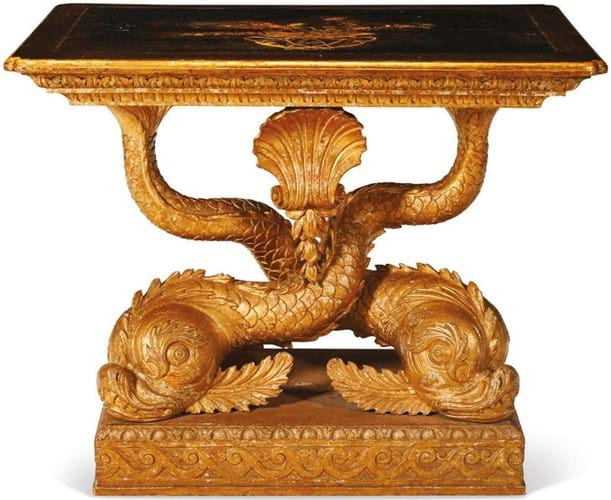
Palladian style pier table of c.1730 – $250,000 (£221,125) at Christie's sale of the Getty collection.
Christie’s Images Ltd 2022
This 3ft 3in (99cm) wide oil gilt Palladian style pier table of c.1730 is inset to the top with a 17th century Japanese lacquer panel set on a robust Kentian inspired design of entwined dolphin supports.
It is attributed to Benjamin Goodison who was closely associated with William Kent, was royal cabinetmaker to George II and supplied furniture to several members of the aristocracy.
It has various labels: one in manuscript inscribed Studley Staircase, another EH and a third from loft, and is thought almost certainly to have been supplied to John Aislabie for Studley Royal, Yorkshire, passing by descent until sold by Christie’s in 1966.
Ann and Gordon Getty acquired the table from Sotheby’s sale of the Hochschild Collection of English Furniture held in 1978.
Last month it featured in the third live auction of works from their collection where it made one of the top prices in this session, selling for $250,000 (£221,125) – more than double the $80,000-120,000 estimate.
Regency occasional tables
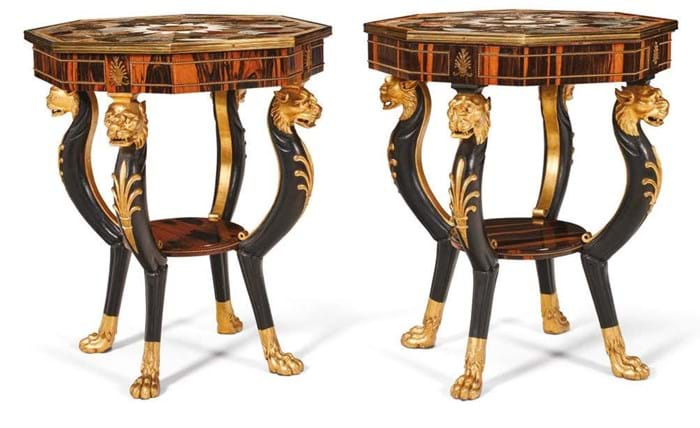
Pair of Regency period octagonal occasional tables from c.1810 – $340,000 (£300,885) at Christie's sale of the Getty collection.
Christie’s Images Ltd 2022
One of the highest prices in the fourth session of the Getty auctions, on October 23, was the $340,000 (£300,885) paid for this pair of 2ft 2in (66cm) wide Regency period octagonal occasional tables from c.1810 estimated at $80,000-120,000.
They are made from ebonised and calamander wood that is parcel gilt, have specimen marble tops composed of figured, volcanic and fossil marbles and are set on leopard monopodia. Their distinctive form closely resembles a design in Thomas Hope’s famous Household Furniture and Interior Decoration of 1807. The tables are thought to have possibly been commissioned by Charles Compton, 1st Marquess and 9th Earl of Northampton for Castle Ashby, Northamptonshire, and passed down by descent until they were offered for sale at Christie’s London in November 1990 when they made a hammer price of £95,000 and were acquired by the Gettys.
Another highpoint of the Regency furniture in the Getty sale was provided by an ormolu mounted mahogany centre table, c.1810, with a scagliola and polychrome-painted white marble top, c.1790. The base, perhaps by Tatham and Marsh of Mount Street, Mayfair, closely follows an illustration in Recueil de Décorations Intérieures (1812) by architects and interior designers Charles Percier and Pierre-François-Léonard Fontaine.
The spectacular top may be by Bartoli and Richter, the ‘Inlayers in Marbles and Stucco-workers’ employed by Robert Adam on some of his high-profile projects.
Last sold at Sotheby’s in July 1992 for £165,000, it brought $200,000 (£176,990) in the Getty auction.
George III giltwood armchairs
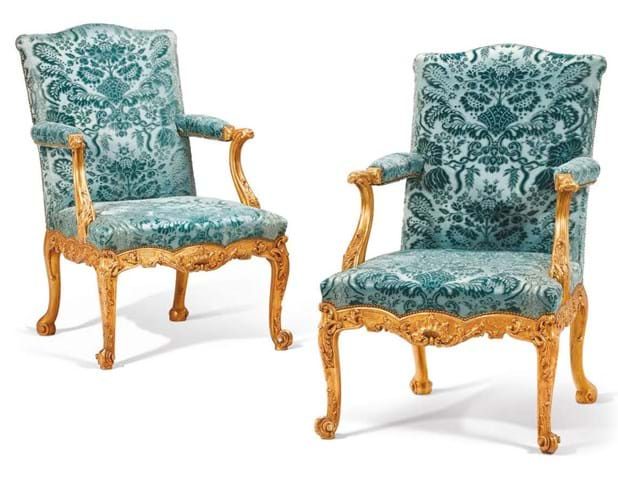
George III giltwood armchairs of c.1765 – $300,000 (£265,485) at Christie's sale of the Getty collection.
Christie’s Images Ltd 2022
Another of the many examples of English seat furniture with a country house provenance was this pair of George III giltwood armchairs of c.1765 which featured in the fourth of the Getty live auctions on October 23.
They were commissioned by Sir William Lee for the drawing room of Hartwell House, Buckinghamshire, whose contents were sold by Christie’s in 1938.
Their design has several features closely relating to the ‘French Chairs’ reproduced in plates in Thomas Chippendale’s 1763 edition of The Gentleman and Cabinet-Maker’s Director. Ann and Gordon Getty acquired the chairs at a Christie’s auction in London in 1992 when they made a hammer price of £55,000. Offered last month with an estimate of $50,000-80,000, they ended up selling for $300,000 (£265,485).
Lead and giltwood chairs
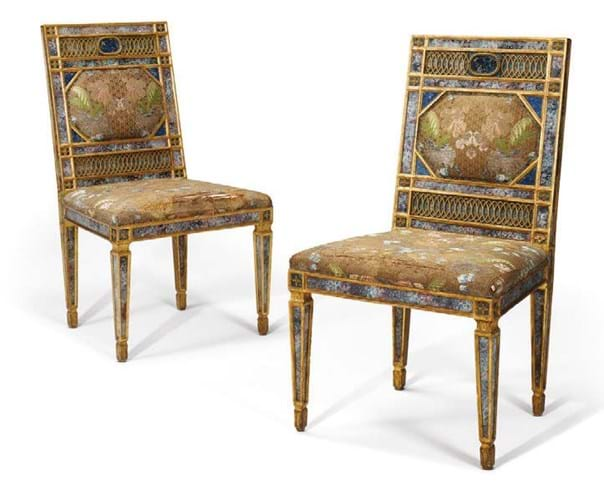
Pair of lead and giltwood chairs – $110,000 (£97,355) at Christie's sale of the Getty collection.
Christie’s Images Ltd 2022
With reverse-painted glass panels painted in imitation of various hardstones, this pair of lead and giltwood chairs are part of a celebrated suite of 20 chairs and four settees made in Sicily c.1780.
For many years they were in the Drawing Room of the Villa Palagonia at Bagheria, near Palermo but shortly before the First World War were bought by the Earl of Derby for his London home. Dispersed across various private and public collections since the 1950s, a settee ($16,000) and four chairs ($16,000 per pair), formerly in the Alsdorf collection, were sold Christie’s, New York in 2020. Te Getty factor meant this pair, bought at Sotheby’s New York in 1990, sold at $110,000 (£97,355).
George III window seats
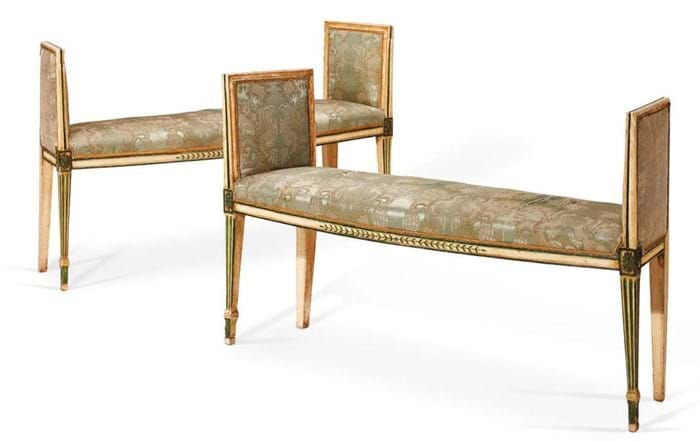
George III period window seats from c.1790 – $4200 (£3715) at Christie's sale of the Getty collection.
Christie’s Images Ltd 2022
The online sales of works from the Getty collection that followed the live auctions offered plenty of opportunities for purchases at a more affordable level.
This pair of 3ft 10in (1.17m) wide cream and polychrome painted George III period window seats from c.1790 was acquired by the Gettys from the auction of the estate of Wendell Cherry at Sotheby’s New York in 1994. In the online sale of English and European decorative arts last month they sold for $4200 (£3715) against a guide of $5000-8000.
Faber dinner service
Each piece of this Belgian porcelain part dinner service by Frederick Theodore Faber is finely painted after Buffon with a different mammal identified in script.
As well as 118 dinner plates and 24 soup plates were an array of serving pieces including a soup tureen, cover and stand. Probably made in c.1820 for King William I of the Netherlands, Prince of Orange-Nassau, Grand Duke of Luxembourg (1772- 1843), it was acquired by Ann and Gordon Getty from Sotheby’s, Monaco in 1984.
It led the ceramics offering at the Getty sale selling for $300,000 (£265,485) against an estimate of $60,000-80,000.
£1 = $1.13


